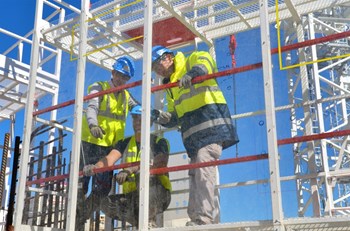
Using transparent Plexiglas rather than traditional plank formwork makes it easy to detect any potential conflict between the position of the steel rods and that of the embedded plates. The pencil marked positions of the plates and studs are clearly visible on this photo. From left to right: Laurent Patisson (ITER), Vincenzo Sarica (Engage) and Paul Lugardon (SOCOTEC).
During the construction of the Tokamak Complex, some 80,000 embedded plates need to be positioned in the rebar lattice prior to pouring concrete.
Embedded plates built into the floors, walls and ceilings of the seven-storey structure will provide strong anchorage for equipment such as tanks, piping, cable trays, feeders and diagnostics.
Each plate is assigned a precise position by the construction design documents and 3D Configuration Management Model. However, in some strategic areas of the Tokamak Complex, the steel reinforcement is so dense that specific techniques need to be implemented to position the plates within extremely narrow tolerances.
This is the case with the bioshield—the 3.2-metre-thick circular structure surrounding the Tokamak, whose role is to protect workers and the environment from radiation generated by the fusion reaction.
The bioshield also has another function: it provides robust anchorage for the 18 radial walls of the cryostat "
crown," which distributes the considerable forces exerted by the combined mass of the Tokamak machine and the cryostat (25,000 tons) and by their movement during operations.
The structural "suite" formed by the crown, the radial walls and the bioshield is one of the most strategic of the entire installation. A full scale
mockup, built to test constructability, has already provided some valuable lessons.
One of the lessons is the temporary replacement, on the inner wall of the bioshield, of the traditional plywood formwork with see-through Plexiglas panes.
"Based on the construction design documents, the precise positioning of the embedded plates and of each of their studs is pencil-marked on the transparent Plexiglas," explains ITER's civil works team coordinator Laurent Patisson. "As we progressively install the steel rods for the bioshield, we can easily detect any potential conflict between their position and that of the plates and therefore adapt as necessary the location of either the rebar or the studs welded on the plates."
Using Plexiglas instead of wooden planks to achieve better precision is nothing revolutionary. But in the utterly complex and challenging world of ITER construction, every detail counts. A plate misplaced by one or two centimetres might seem inconsequential. In ITER, nothing is.







